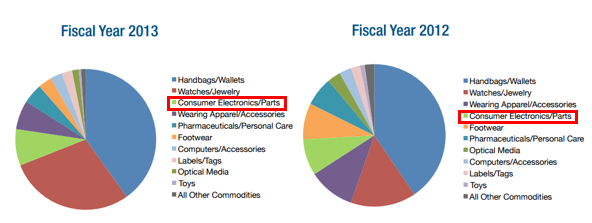Global consumer electronics market is still full of potential
Consumer electronics (CEs) are electronic or digital equipment intended for everyday use. Consumer electronics include devices used for entertainment, communications and home-office etc. such as telephones, laptops, iPods, video games, DVD players and so on. (Source: Wikipedia)
According to Statista, the wholesale revenue of the consumer electronics market in the United States shows a steady increase from 2009 (169.79 billion USD) to 2015(220.9 billion USD).

Worldwide, Gartner predicted that even though the double-digit growth era for the global smartphone market has come to an end because we may see the extension of the phone lifetimes of the users in mature markets such as North America, Western Europe and Japan, the countries like India will still help generate new mobile phone user growth.
The truth is, according to Investopedia, one of the fastest-growing regional electronics sectors is India. In January 2015, the India Electronics and Semiconductor Association (IESA) predicted that its electronics sector would grow by 10% in 2015 and possibly faster in 2016. The IESA also suggested that nearly 60% of future market growth would be driven by mobile phones, televisions and other computing devices.
Counterfeit consumer electronics market is “full of potential” as well



Nowadays, electronics industry not only suffers from counterfeits via the traditional offline channels but also the prosperous online channels.
Endless battle between the counterfeits and the genuine
For offline channel, such as Huaqiangbei commercial area on Shenzhen, China. It is recognized as a major electronics manufacturing hub in China, therefore it earned the nicknames such as “China’s Silicon Valley”. It has notorious history of selling counterfeit and smuggled goods.
Actually, in the place like Huaqiangbei, there are many levels of counterfeits: genuine, fake and in-between (many levels of in-between as well, such as imitation goods, parallel goods,
refurbished goods, brand new goods and so on. In Chinese: (仿货、水货、翻新货、全新货). Those stores can change IPhone 5C to 5S, change IPhone 5S to SE, reassemble phone, repack phone to appear as the new one… and these are small part of counterfeits in phone category only.
Besides the traditional offline channel, E-commerce platform, in some extent, may provideconvenience for the counterfeits producer. If you key-in the keywords such as “IPhone cable” in taobao.com, you can find more than a hundred pages of commodities within one second, and the price varies from less than 10 to more than 100 CNY, but the price of the IPhone cable is 149 CNY in online apple store, do we really have the methods to identify which one is fake or genuine?
Trashed, recycled or inexpensive products are spiffed up and made to look like the brand new and higher-end products by the counterfeits producer. The frustrating truth of those criminal activities is when the original equipment manufacturers (OEMs) update their products, counterfeiters follow suit. When OEMs incorporate special markings for identification purposes, the best counterfeiters improve their design so that the real and fake products are identical. Each side is always trying to fool the other. It’s a frustrating cycle that has forced the industry to up its game.
What more we need to know?
What’s worse? The graphic only shows the discovered loss of value by counterfeit consumer electronics. Obviously the actual value which brand owners loose is much higher. One must also recognize that counterfeit consumer electronics do not only hurt sales, but can also strain budgets allocated for after sales due to warranty return and service fraud. The unhappy customer who bought the fake products may contact the brand owner for the return and warranty work, without the effective identifying technology, the unnecessary after-sell service may eat away the profits of the brand owner as well.
The counterfeit electronic products can also damage brand image and value by causing tons of accidents. Fake electronics producers always sacrifice the quality of the product in order to seek the profit margin, at the same time, they sacrifice the protection of their customer as well. The accidents include power bank explosion, electricity leakage, fire broke out and so on. The following lawsuits and compensation can cause loss if the brand owner does not have powerful evidence to clarify that the products are fake.
NanoMatriX is the expert in anti-counterfeiting solutions with over 10 years’ experience. We provide free consulting services and highly personalized brand protection solution and marketing strategies, which will help you work against counterfeits and win more customers simultaneously.
Join our webinar to learn more about some of the most advanced technologies and strategies to fight counterfeits in electronic industry.
Get a FREE CONSULTATION Now!

